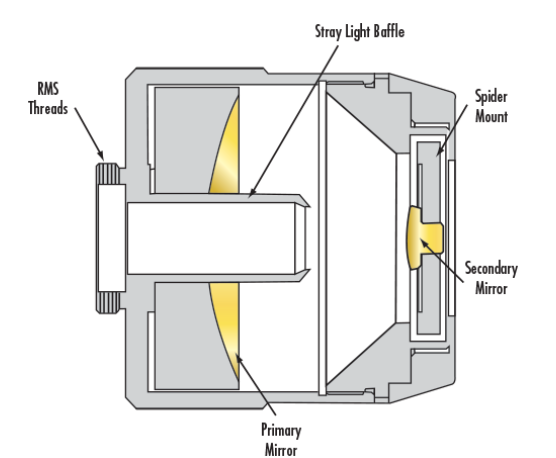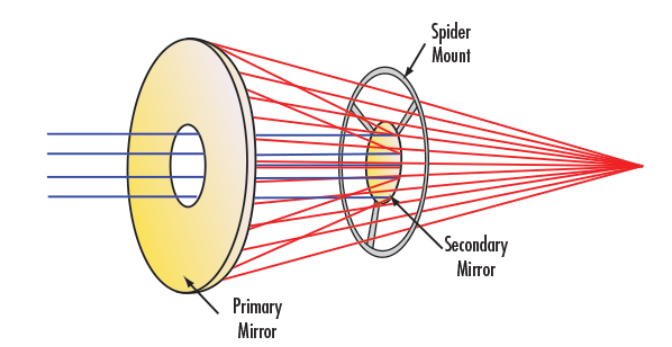Microscope objective lenses are one of the most recognizable components in microscope design. These lenses magnify the image, allowing the human eye to easily view through the eyepiece or imaging systems such as imaging lenses and cameras. The traditional design of objective lenses is refractive; in other words, they consist of a series of optical lenses. However, the demand for high-power focusing optics, from deep ultraviolet to far-infrared with color correction, has driven the industry to develop affordable, off-the-shelf microscope objective lenses for these wavelengths—reflective or mirror-based objective lenses are the answer. These objective lenses use a reflective design with two or more mirrors to focus light or form an image.
The most common type of reflective objective lens is the dual-mirror Schwarzschild objective (Figure 1). This system consists of a small-diameter "secondary" mirror and a large-diameter "primary" mirror with a central hole, with the secondary mirror held in place by a star-shaped mount. The primary and secondary mirrors are indicated with gold coating to better illustrate their positions within the reflective objective housing. These mirror-based objective lenses come in two configurations: infinity-corrected for focusing applications and finite conjugate for imaging applications.

Types of Reflective Objective Lenses
Infinity-Corrected Reflective Objective Lenses Infinity-corrected reflective objective lenses (Figure 2) are ideal for focusing applications. Collimated light (such as a laser source) enters the objective lens through the central aperture of the primary mirror and is focused at a specified working distance. This configuration provides an economic means to focus broadband or multiple laser sources to a single point. A common application is focusing infrared (IR) or ultraviolet (UV) lasers (such as Nd:YAG lasers), which often include a visible reference beam.

Finite Conjugate Reflective Objective Lenses Finite conjugate reflective objective lenses (Figure 3) are ideal for imaging applications. They offer a straightforward solution without the need for any additional focusing optics. This finite conjugate mirror-based configuration provides excellent resolution and can often be used interchangeably with traditional refractive microscope objective lenses. Infinity-corrected reflective objective lenses can be used in imaging applications by adding a tube lens, providing additional flexibility in manipulating the optical path.

Advantages of Reflective vs. Refractive Microscope Objective Lens Designs
The primary advantage of reflective objective lenses over refractive objective lenses is their color correction across a wide spectral range. Refractive objective lenses provide similar performance within a limited range, such as the visible spectrum, which is quite popular. However, as the wavelength range begins to exceed the design range, transmission and image performance are compromised. Additionally, there are numerous reflective coatings available that offer unparalleled performance in the deep ultraviolet, infrared, and specific laser wavelengths.
Key Metrics for Reflective Objective Lenses
When comparing reflective objective lenses, two parameters unique to these mirror-based systems should be considered: obscuration and transmitted wavefront. In reflective systems, the central portion of the primary mirror does not transmit light to the secondary mirror but instead reflects it back through the stray light baffle. To avoid this, many manufacturers place an absorbing coating on the central portion of the primary mirror. There are two other locations where obscuration occurs: the diameter of the primary mirror and the width of the spider-leg-like structure. It is best to include all contributions from obscuration in the specified values, although some manufacturers only include the contribution from central obscuration.
Transmitted wavefront error is perhaps the most critical parameter for many applications requiring reflective objective lenses; transmitted wavefront error is the difference in the wavefront as it enters and exits the system. Recent advances in mirror manufacturing have made the production and testing of high-precision surfaces possible, creating better-corrected systems. Mirrors with λ/20 peak-to-valley (P-V) tolerances can be achieved, allowing the production of reflective objective lenses with transmitted wavefront ≤λ/4 P-V.
This low wavefront error allows reflective objective lenses to have diffraction-limited or near-diffraction-limited performance. Diffraction-limited objective lenses produce the smallest focused spot size defined by an Airy disk, which can be calculated using the objective lens's numerical aperture (NA) and wavelength:

While traditional refractive objective lenses are well-suited for a range of applications within specific wavelength bands, reflective objective lenses can be used as a replacement to enhance performance and image quality in broadband applications from deep ultraviolet to far-infrared. Reflective objective lenses are ideal for applications such as Fourier transform infrared spectroscopy, laser focusing, and ellipsometry, where diffraction-limited performance and chromatic correction are crucial.